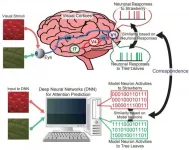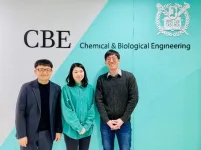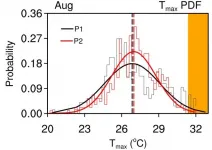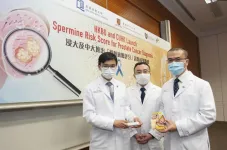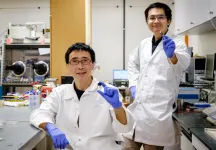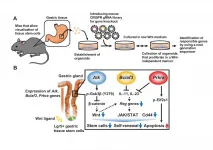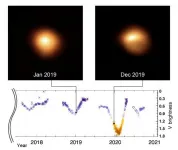(Press-News.org) Geoscientists have released a video that for the first time shows the uninterrupted movement of the Earth's tectonic plates over the past billion years.
The international effort provides a scientific framework for understanding planetary habitability and for finding critical metal resources needed for a low-carbon future.
It reveals a planet in constant movement as land masses move around the Earth's surface, for instance showing that Antarctica was once at the equator.
The video is based on new research published in the March 2021 edition of Earth-Science Reviews.
Co-author and academic leader of the University of Sydney EarthByte geosciences group, Professor Dietmar Müller, said: "Our team has created an entirely new model of Earth evolution over the last billion years.
"Our planet is unique in the way that it hosts life. But this is only possible because geological processes, like plate tectonics, provide a planetary life-support system."
Lead author and creator of the video Dr Andrew Merdith began work on the project while a PhD student with Professor Müller in the School of Geosciences at the University of Sydney. He is now based at the University of Lyon in France.
Co-author, Dr Michael Tetley, who also completed his PhD at the University of Sydney, told Euronews: "For the first time a complete model of tectonics has been built, including all the boundaries"
"On a human timescale, things move in centimetres per year, but as we can see from the animation, the continents have been everywhere in time. A place like Antarctica that we see as a cold, icy inhospitable place today, actually was once quite a nice holiday destination at the equator."
Co-author Dr Sabin Zahirovic from the University of Sydney, said: "Planet Earth is incredibly dynamic, with the surface composed of 'plates' that constantly jostle each other in a way unique among the known rocky planets. These plates move at the speed fingernails grow, but when a billion years is condensed into 40 seconds a mesmerising dance is revealed.
"Oceans open and close, continents disperse and periodically recombine to form immense supercontinents."
Earth scientists from every continent have collected and published data, often from inaccessible and remote regions, that Dr Andrew Merdith and his collaborators have assimilated over the past four years to produce this billion-year model.
It will allow scientists to better understand how the interior of the Earth convects, chemically mixes and loses heat via seafloor spreading and volcanism. The model will help scientists understand how climate has changed, how ocean currents altered and how nutrients fluxed from the deep Earth to stimulate biological evolution.
Professor Müller said: "Simply put, this complete model will help explain how our home, Planet Earth, became habitable for complex creatures. Life on Earth would not exist without plate tectonics. With this new model, we are closer to understanding how this beautiful blue planet became our cradle."
Key points:
Plate tectonics are responsible for the deep-carbon and deep-water cycles.
Arrangement of continents has changed sea level in the past.
The evolution of life is modified by tectonics - continents are rafts with evolving species that mix when continents combine.
A growing focus on renewable and low-carbon technologies will mean we need to find more copper and other resources. To find these deposits our new models of plate tectonics will help reduce the environmental footprint of mineral exploration and extraction.
INFORMATION:
RESEARCH
Merdith, A.S., et al. 'Extending full-plate tectonic models into deep time: Linking the neoproterozoic and the phanerozoic'. Earth-Science Reviews.
DOI: 10.1016/j.earscirev.2020.103477
VIDEO https://www.youtube.com/watch?v=gQqQhZp4uG8
DOWNLOAD photos and a copy of the paper at this link.
INTERVIEWS
Professor Dietmar Müller | EarthByte Group | School of Geosciences |
dietmar.muller@sydney.edu.au | +61 434 606 914
MEDIA ENQUIRIES
Marcus Strom | marcus.strom@sydney.edu.au | +61 423 982 485
DECLARATION
The EarthByte Group at the University of Sydney is supported by the Australian Research Council. Other support for the research came from the National Natural Sciences Foundation of China; the European Research Council; Agence Nationale de la Recherche of France; Alfred P. Sloan grants through the Deep Carbon Observatory; the Richard Lounsbery Foundation; the AuScope National Collaborative Research Infrastructure System (NCRIS) program.
This discovery was made possible by applying the research method for the comparison of the brain activity between monkeys and humans to artificial neural networks. This finding might be helpful not only to understand the cortical mechanism of attentional selection but also to develop artificial intelligence.
Deep neural networks (DNNs), which are used in the development of artificial intelligence, are mathematical models for obtaining appropriate mechanisms to solve specific problems from the training with a large-scale dataset. However, the detailed mechanisms underlying DNNs through ...
On Feb 5th, Seoul National University, College of Engineering (Dean Kookheon Char) announced that Professor Sang Woo Seo's research team (Dr. Jina Yang and Mr. Yong Hee Han (graduate student)) at School of Chemical and Biological Engineering has developed a synthetic protein quality control system to enhance full-length translation in bacteria. This technology is expected to increase the efficiency of the production of biopharmaceuticals, industrial enzymes, and bio-based chemicals.
Recombinant proteins are used in various industrial fields from protein drugs such as insulin to industrial proteins such as laundry detergents. Since proteins can perform their functions only with full-length and proper 3D structure, recombinant protein production ...
Against the background of global warming, extreme heat days (EHDs) occur frequently and greatly threaten human health and societal development. Therefore, it is of great importance to understand the variation of EHDs.
Previous studies have indicated that the frequency of EHDs is mainly modulated by the mean state of temperature, and thus the frequency of EHDs mostly presents an increasing trend.
"However, the variability of the daily maximum temperature also plays an important role in the interdecadal change of extreme heat days over Northeast China," says Ms. Liu Wenjun, a Master's student from the group of Dr. Ruidan Chen in the School of Atmospheric Sciences ...
Researchers from Hong Kong Baptist University (HKBU) and the Faculty of Medicine at The Chinese University of Hong Kong (CU Medicine) have jointly developed the Spermine Risk Score which, coupled with the use of a urine test, provides a non-invasive and more reliable method for the diagnosis of prostate cancer. In a study conducted by the researchers, about 37% of the patients, who were ultimately found to have no prostate cancer, can avoid undergoing a prostate biopsy procedure. The findings have just been published in the scientific journal Prostate Cancer and Prostatic Diseases.
Demand for more reliable and non-invasive diagnosis
Prostate cancer is the third most common and the fourth most fatal cancer for the male ...
Which bananas end up in your shopping basket-- the uniformly yellow ones or those with brown spots?
If you are like most people, you skip the spotted ones and select those that are perfectly yellow. This is because emotions play an an oversized role in our shopping decisions, according to a new study by Danish and Swedish researchers.
"We choose food based upon an expectation of what it will taste like that is bound to our feelings. So, if we expect a brown banana to not match the taste of a yellow one, we opt for the latter," explains Karin Wendin, an associate professor at University of Copenhagen's Department of Food Science, and one of the researchers behind the study.
Approximately 716,000 tonnes ...
A team of researchers led by Nanyang Technological University, Singapore (NTU Singapore) has developed a new material, that when electricity is applied to it, can flex and bend forty times more than its competitors, opening the way to better micro machines.
Conversely, when it is bent, it generates electricity very effectively and could be used for better "energy harvesting" - potentially recharging batteries in gadgets just from everyday movements.
The novel material is both electrostrictive and piezoelectric. Its electrostrictive properties means it can change shape when an electric current is applied, while piezoelectric means the material can convert pressure into electric charges.
When an electric field is applied, the atoms that make up electrostrictive ...
Although SGLT-2 inhibitors are central to the treatment of diabetes, their exact mode of action was hitherto unknown. In a study conducted by a research group led by Peter Wolf, Martin Krssak and Michael Krebs from MedUni Vienna's Department of Medicine III, magnetic resonance spectroscopy (MRS) was used to show that there is a direct correlation between the elimination of glucose via the kidneys and new glucose production in the liver. A single dose of the SGLT-2 inhibitor dapagliflozin gives rise to a beneficial regulation mechanism, in which glucose loss due to drug-induced SGLT-2 inhibition is exactly balanced out by an equal increase in new glucose production in the liver. The study has been published in the leading journal Diabetes Care.
Dapagliflozin is a drug from the group ...
Researchers at the Kobe University Graduate School of Science have revealed that when captive-bred juvenile red-spotted masu salmon are released into natural streams, very few individuals become migrants.
Red-spotted masu salmon was an important fish species for the fishing industry in the rivers of west Japan, however in recent years their numbers are declining rapidly. The results of this research offer important suggestions for stocking practices and the management of river environments.
The research group consisted of graduate school students TANAKA Tatsuya and UEDA Rui and Associate Professor SATO Takuya. The results were published in Biology Letters ...
[Background]
The human body consists of about 60 trillion cells that are renewed day by day to maintain homeostasis of body tissues. In particular, cells of the digestive tract are renewed completely within several weeks thanks to vigorous proliferation where tissue stem cells of every tissue play critical roles in supplying those cells. Tissue stem cells play essential roles in various phenomena such as histogenesis and recovery from damage by producing differentiated cells while dividing. They do this by producing identical cells (self-renewal) or by differentiating into other types of cells. The research team led by Profs. Murakami and Barker of the Cancer Research Institute, Kanazawa University revealed ...
Betelgeuse is normally one of the brightest, most recognizable stars of the winter sky, marking the left shoulder of the constellation Orion. But lately, it has been behaving strangely: an unprecedentedly large drop in its brightness has been observed in early 2020 (Figure 1), which has prompted speculation that Betelgeuse may be about to explode.
To find out more, an international team of scientists, including Ken'ichi Nomoto at the Kavli Institute for the Physics and Mathematics of the Universe (Kavli IPMU), conducted a rigorous examination of Betelgeuse. They concluded that the star is in the early core helium-burning phase (which is more than 100,000 ...
